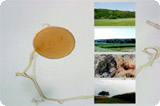séminaire d’agroécologie – lundi 6 octobre 2008
 Molecular ecology and evolution of arbuscular mycorrhizal fungi: from species communities to populations
Molecular ecology and evolution of arbuscular mycorrhizal fungi: from species communities to populations
Dirk Redecker, université de Bâle
lundi 6 octobre 2008, à 11 heures, salle des conférences de l’INRA
Molecular markers are an indispensable tool to analyze phylogeny and evolutionary ecology of arbuscular mycorrhizal fungi (AMF, Glomeromycota). Regions of the nuclear-encoded ribosomal RNA have been instrumental in elucidating the phylogeny of the Glomeromycota and are still the only molecular marker genes available across all families of AMF. Molecular tools based on these genes have been used extensively in field studies for identification of AMF symbionts within colonized roots, revolutionizing our views of AMF communities in natural and human-influenced ecosystems. In AMF, ecology, the loss of species-level diversity in arable soils is a key question. We showed that species richness in arable soils is not necessarily very low, contrary to findings from previous studies. Our molecular analyses of life history strategies of AMF contributed additional evidence to better understand the dynamics of AMF communities in arable systems. Nuclear-encoded ribosomal RNA genes show considerable intra-isolate and intra-spore sequence polymorphism which complicates using them to distinguish closely-related AMF taxa and makes it impossible to discern isolates of the same species. We found that in contrast the mitochondrial large RNA subunit (mtLSU) is homogeneous within AMF isolates tested so far. Nevertheless, the variable regions of this gene, in particular the introns, allow to efficiently distinguish not only morphospecies of Glomus, but also isolates of Glomus intraradices. The respective gene region from other glomeromycotan taxa was amplified and sequenced to test the feasibility of a similar approach in other AMF lineages. Among 16 cultivated isolates of G. intraradices originating from five continents, 12 mtLSU haplotypes were distinguished, indicating that this gene region is a promising molecular marker to study intraspecies genetic diversity. Specific PCR primers to amplify the mtLSU region directly from colonized roots have been designed and tested and are currently used to elucidate mtLSU haplotype diversity in field populations. Together with recently developed other polymorphic markers (« microsatellites »), mtLSU will be a useful tool to elucidate the population structure of G. intraradices and other species. G. intraradices has been detected in an extremely broad range of habitats, the species is very frequently found in roots from arable soils, can be cultivated relatively easily and has been selected for genome sequencing. Therefore, analyzing the population structure of this species would be a significant step forward towards a better understanding of the ecology of AMF in arable systems and would provide important hints how to manage this natural resource.
- kc_data:
- a:8:{i:0;s:0:"";s:4:"mode";s:0:"";s:3:"css";s:0:"";s:9:"max_width";s:0:"";s:7:"classes";s:0:"";s:9:"thumbnail";s:0:"";s:9:"collapsed";s:0:"";s:9:"optimized";s:0:"";}
- kc_raw_content:
 Molecular ecology and evolution of arbuscular mycorrhizal fungi: from species communities to populations
Molecular ecology and evolution of arbuscular mycorrhizal fungi: from species communities to populationsDirk Redecker, université de Bâle
lundi 6 octobre 2008, à 11 heures, salle des conférences de l'INRA
Molecular markers are an indispensable tool to analyze phylogeny and evolutionary ecology of arbuscular mycorrhizal fungi (AMF, Glomeromycota). Regions of the nuclear-encoded ribosomal RNA have been instrumental in elucidating the phylogeny of the Glomeromycota and are still the only molecular marker genes available across all families of AMF. Molecular tools based on these genes have been used extensively in field studies for identification of AMF symbionts within colonized roots, revolutionizing our views of AMF communities in natural and human-influenced ecosystems. In AMF, ecology, the loss of species-level diversity in arable soils is a key question. We showed that species richness in arable soils is not necessarily very low, contrary to findings from previous studies. Our molecular analyses of life history strategies of AMF contributed additional evidence to better understand the dynamics of AMF communities in arable systems. Nuclear-encoded ribosomal RNA genes show considerable intra-isolate and intra-spore sequence polymorphism which complicates using them to distinguish closely-related AMF taxa and makes it impossible to discern isolates of the same species. We found that in contrast the mitochondrial large RNA subunit (mtLSU) is homogeneous within AMF isolates tested so far. Nevertheless, the variable regions of this gene, in particular the introns, allow to efficiently distinguish not only morphospecies of Glomus, but also isolates of Glomus intraradices. The respective gene region from other glomeromycotan taxa was amplified and sequenced to test the feasibility of a similar approach in other AMF lineages. Among 16 cultivated isolates of G. intraradices originating from five continents, 12 mtLSU haplotypes were distinguished, indicating that this gene region is a promising molecular marker to study intraspecies genetic diversity. Specific PCR primers to amplify the mtLSU region directly from colonized roots have been designed and tested and are currently used to elucidate mtLSU haplotype diversity in field populations. Together with recently developed other polymorphic markers ("microsatellites"), mtLSU will be a useful tool to elucidate the population structure of G. intraradices and other species. G. intraradices has been detected in an extremely broad range of habitats, the species is very frequently found in roots from arable soils, can be cultivated relatively easily and has been selected for genome sequencing. Therefore, analyzing the population structure of this species would be a significant step forward towards a better understanding of the ecology of AMF in arable systems and would provide important hints how to manage this natural resource.
- extrait:
- lien_externe:
- titre:
- Molecular ecology and evolution of arbuscular mycorrhizal fungi: from species communities to populations
- intervenant:
- Dirk Redecker
- date:
- lundi 6 octobre 2008
